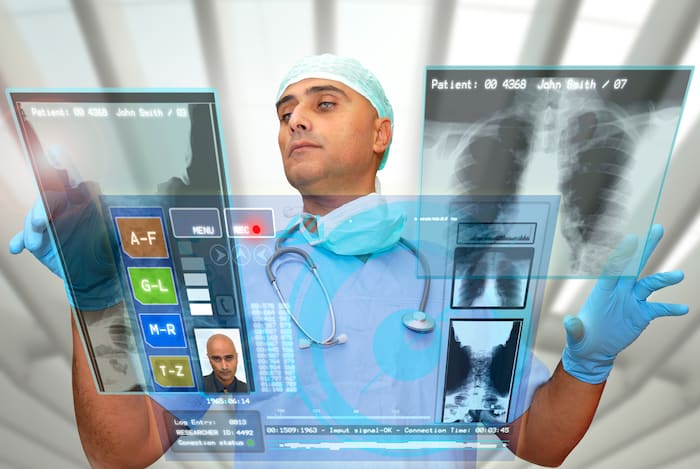Cool Photos from Depositphotos
By Paul Banco, CEO and co-founder of etherFAX
It may be a new year, but healthcare organizations are still reeling from the pandemic. With an increase in COVID cases, a shortage of workers, and mounting cybersecurity threats, it’s no surprise that physician burnout is at an all-time high.
As organizations try to keep pace with the uptick in in test results and medical records being transmitted, new devices and remote connections continue to be implemented into their networks. The use of telehealth has also grown exponentially. According to a brief from the U.S. Department of Health and Human Services, the number of telehealth primary care visits increased 350-fold at the height of the pandemic. Unfortunately, this has also increased security risks across the nation.
A 2020 report from SecurityScorecard andDarkOwl LLC found a 117% increase in IP reputation security alerts, typically caused by successful malware infections through phishing attempts and other attack vectors, a 42% increase in FTP issues, indicating trouble with a nonsecure network protocol that enables information to travel between a client and a server on a network, and a 56% increase in issues related to endpoint security.
To secure healthcare technology during the pandemic and beyond, organizations must extend legacy devices, remote connections, and telehealth services to a secure exchange network via the cloud. Hybrid-cloud fax technology can provide end-to-end encryption, two-factor authentication, and direct transmissions to protect patient data and business-critical communications.
Digital Faxing
Many patients and organizations are unaware that a data exchange via email or text message will typically pass through multiple servers before it reaches the final point of delivery. This indirect transmission method can leave PHI and other unstructured data vulnerable to imminent threats of cyberattacks.
Utilizing a hybrid-cloud network with direct digital faxing can prevent communications from traversing an external telephone network and protect data from unauthorized access. Black and White lists can also be leveraged to place further restrictions on the exchange of sensitive information.
Additionally, digital and direct fax solutions offer the flexibility to integrate with today’s popular mobile applications and third-party messaging platforms, such as Microsoft Teams and Slack, while maintaining HIPAA, SOC 2, and PCI DSS compliance. With the ability to quickly and securely send and receive documents from anywhere, at any time, healthcare providers can spend less time processing paperwork and more time delivering quality patient care.
HITRUST CSF Certification
The HITRUST CSF certification has become the gold standard for compliance framework in the healthcare industry as it addresses the requirements of existing standards and regulations including HIPAA, PCI, COBIT, NIST, ISO, FTC, and state laws. While the HITRUST CSF can be used by all organizations that create, access, store, or exchange sensitive and/or regulated data, it is ideal for healthcare organizations because of its prescriptive framework for managing the security requirements inherent in the Health Insurance Portability and Accountability Act.
HITRUST offers providers a trusted benchmark from which they can measure and manage their own compliance, while offering proven protection to their patients and partners. For guaranteed security, healthcare organizations should look for a fax provider that is HITRUST CSF certified in addition to SOC 2 and PCI DSS compliant.
End-to-End Encryption
Implementing a secure exchange network that leverages well-defined end-to-end encryption methods, such as those defined in the Elliptic Curve Integrated Encryption Scheme (ECIES), is crucial to fully protect the transfer of information between two endpoints. With end-to-end encryption, even if a third-party attempted to eavesdrop on the network communication, the information itself would be indecipherable.
Two-factor authentication (2FA) should also be utilized on every device that sends and receives PHI. Two-factor authentication can prevent data breaches on applications and platforms by requesting a combination of credentials at access points that only the actual patient, doctor, billing operator, or pharmacist would know.
Fax for the Future
In 2022, adopting new technology shouldn’t adversely affect security and privacy. To ensure that protected health information (PHI) remains secure at all times, organizations should utilize a hybrid-cloud fax network that leverages defense-in-depth strategies including end-to-end encryption and two-factor authentication. Direct, digital fax solutions also offer more versatility and can easily integrate with messaging apps to optimize workflows.
ABOUT THE AUTHOR
As CEO and co-founder of etherFAX, Paul Banco is responsible for the strategic direction of the company and leads technology development, including the patented etherFAX and etherFAX SEN intellectual property. In 2009, he identified the need to leverage the cloud for secure document delivery and co-founded etherFAX with fellow telecom industry veterans. As a cloud-based and virtual solution, etherFAX enables healthcare organizations to securely send and receive information from a broad range of applications and endpoint devices.
The Editorial Team at Healthcare Business Today is made up of skilled healthcare writers and experts, led by our managing editor, Daniel Casciato, who has over 25 years of experience in healthcare writing. Since 1998, we have produced compelling and informative content for numerous publications, establishing ourselves as a trusted resource for health and wellness information. We offer readers access to fresh health, medicine, science, and technology developments and the latest in patient news, emphasizing how these developments affect our lives.









